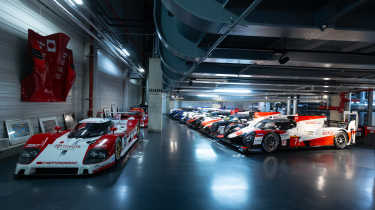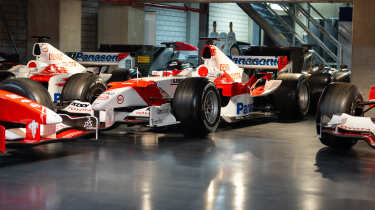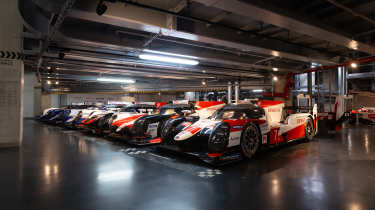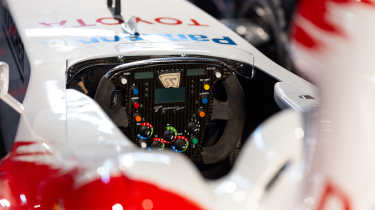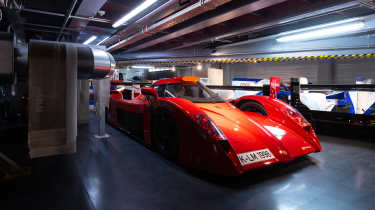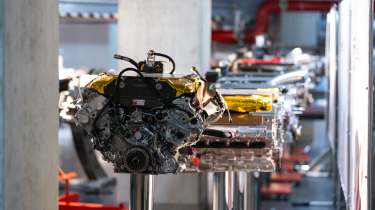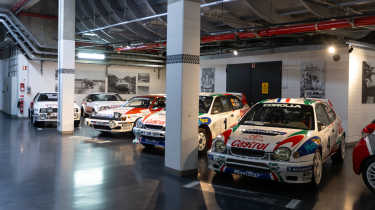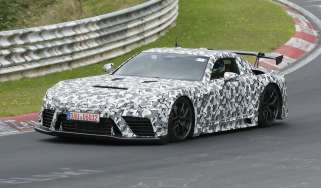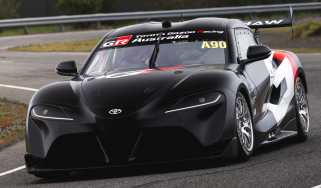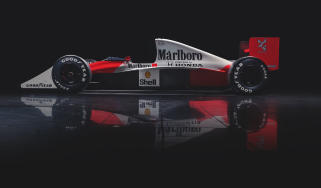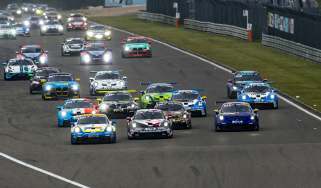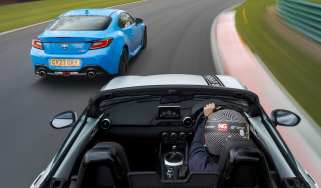Exploring Toyota's greatest motorsport icons, from WRC to Formula 1
Where best to store some of Toyota’s most prized and valuable racing superstars? Under the wind tunnel at its Cologne HQ, of course…
Welcome to a museum like no other. Instead of a theatrical entrance hall or a tantalising gift shop shimmering by the ticket booth, we’ve drawn up at a security gate. Outside a grey box of a factory. Once cleared, we’re chaperoned through corridor after corridor, albeit ones lined with a diverse array of trophies from every corner of the globe. Things are looking up.
As the signal bars on our phones ebb away, we arrive at a pair of doors so large and thick it’s easy to assume they occupy a sole what3words address apiece. They heave open to reveal three-dozen rally, endurance and Formula 1 race cars, all gathered carefully in their respective tribes under enough snaking ventilation pipes to make Kevin McCloud woozy with their industrial chic. It’s the underbelly of the Toyota Gazoo Racing Europe (TGR‑E) wind tunnel facility, the unlikely location for a droolworthy selection of the marque’s motorsport heroes. And our adventure has only just begun.
Storing them here is both an ingenious use of space and an ergonomical challenge. While some areas of the hall boast enough headroom to dangle an old F1 car artfully above visitors – like mechanical mistletoe – others call on you to duck and weave like it’s a Crystal Maze challenge, the sands of the timer dwindling as Richard O’Brien wisecracks at the door. Careful not to trip over any delicate winglets or vulnerable splitters…
There are undoubtedly more spacious places to host such invaluable, irreplaceable objects, but these cars were made with a purity of purpose – designed for gruelling competition and hard-won results – making the brutal aesthetic of their retirement home feel like a fitting backdrop.
Happily, they still get days out. The man orchestrating it all is John Day. His career began as a rally mechanic in 1966, aged 17. After a decade of servicing Fords, he moved to Toyota in 1977 and has spent most of his working life around its motorsport efforts since. He’s seen the name above the door shift several times and the focus switch between rallying, endurance and F1, ending up the proud and fastidious caretaker of these museum-piece mementos along the way. When he’s required to follow one to the other side of the world to help its appearance at an event run smoothly, his bags are packed before the call has even ended.
‘In the beginning, it was the cars that we as mechanics had worked on,’ he says, with a conspiratorial glint in his eye. ‘We put them aside in some out-of-the-way garage, we hid them away. All of us had the same passion for motorsport and these were the cars that we made, we built. It was around the year 2000. It started with us putting a few cars away and has ended up growing into this collection. These cars are our children.’
Mischievous then, but with a noble aim: to save cars destined for the unsympathetic grip of the crusher. ‘It started with two Group S cars,’ he says, referring to the gnarly little MR2-based 222D prototype. ‘There were two versions. Chassis numbers one to seven had transverse engines and eight to 11 were longitudinal. We managed to save one of each; apart from another longitudinal car, all the rest have been scrapped. After that, we saved one of the original 20 Group B cars, which bears no resemblance to a rally car; in its evolution, they all changed. Anything that is built as a prototype car basically ends up scrapped. It is built on a totally different budget and so when that budget ends, everything theoretically gets thrown away. Even the Formula 1 cars should theoretically be scrapped. We were squirrelling these things away so the finance part of our company didn’t see them…’
Toyota discovered what those mechanics were up to fairly quickly, but ever the enthusiast-led company, it allowed the collection to flourish. But does sharing its motorsport heroes between Japan and Europe ever rub anyone up the wrong way? ‘There are discussions, but not at my level,’ John admits. ‘Japan wants anything that’s won an event. With the Le Mans cars, they’ve got two winning examples, a TS050 and a GR010. We’ve got the same while the other winning car is displayed in the official Le Mans museum.
‘Some GT‑Ones are in Japan, some are with us. We have two that are runners, a ’98 and a ’99 car, although these went through evolutions after the Le Mans programme ended because they were being used for Formula 1 testing as well.’ The tennis ball dangling down the centre of their windscreens? A reminder to anyone about to fire the car up that the cover for its roof-mounted air intake needs to be removed before they do…
‘With the exception of probably one car in here, they all have the possibility to run. There isn’t the money available to keep them all running [at once] and some of them can take quite a bit of time to get them going. In the case of the Formula 1 cars you must strip them down to virtually nothing. That’s also the case with most of the World Endurance Championship [WEC] cars, but they have other problems in that some of them were put away as show cars with pieces missing. With both disciplines you can have carryover paths that go from one year to another.’
Still, no one knows how to get these things going quicker than John. ‘Given the time, there is always a way of making them run. There is a GR010 Hybrid Hypercar that we have been exhibiting in Paris at the Olympics and Paralympics. We’ve been there six weeks running it virtually every day.
‘With the F1 cars the trickiest issue, most of the time, is having the laptop for that particular car. A WEC car actually runs three main ECUs, so you’re looking at finding three of the right laptops to just start each example, plus the batteries are never in the car; they can be dangerous if they aren’t taken out to be stored correctly. You certainly need a pretty long lead-time ahead of physically running one. We need at least a couple of months’ notice, a lot of which will be spent recruiting the right team of engineers to look after the car.’
Perhaps it’s no surprise that the rally cars – with their comparative simplicity – are John’s favourites in the collection and that it’s the rallying era that fosters his fondest memories. ‘It began as a small team,’ he muses, referring to TGR‑E’s Swedish origins under Ove Andersson before it moved to Cologne (the headquarters it still occupies) under the Toyota Team Europe banner. ‘Rallying has provided some of our best times. And it breeds a different type of person, a different type of mechanic. Rallying feels a bit more relaxed, we just get on with it and don’t ask questions. With circuit mechanics it can be more like “Are we allowed to do that?”’
Nonetheless, John also has a definite soft spot for the early endurance racers parked alongside a wall of wonderfully nostalgic pictures and memorabilia. ‘The GT‑One project started at the end of 1997 and we were physically building the cars and supporting the project until after ’99. Even though they only did a handful of races [the five racing chassis only contested the 24 Hours of Le Mans, rather than a full championship] it was the hardest work I’ve done in my life. It was 12 hours a day, seven days a week. All the time, full on. It was quite intense. It took me six months to get over that! It was a bit bonkers.
‘The TS010 Group C car is nice, but fragile. Theoretically, it’s the quickest car of all. There’s a great sound to it too – it gives you the biggest rush when you start it, I can tell you.’ Trivia fans might wish to know it’s the only car in the TGR‑E Museum not built by TGR‑E, mind…
Adjacent is a line of endurance racers that spark joy in my own heart. The chronological timeline of hybrid LMP1s and Hypercars is properly arresting and a brisk walk from start to finish guides you through V8 and V6 eras, myriad ACO rulebooks and multiple driver and constructor titles. You could spend hours just poring over their aerodynamic evolution, bold rear fins all stacked neatly in parallel together, while the preservation of their race patina sprinkles some welcome emotion over their engineering. A short stride here belies the huge narrative between the 2016 TS050 that cruelly ground to a halt on the La Sarthe finish line at the 23:57 mark and the 2018 TS050 that Fernando Alonso, Sébastien Buemi and Kazuki Nakajima took to double Le Mans and overall WEC honours.
Then there’s Formula 1. Here John’s experience is even more hands-on. His role during Toyota’s F1 era was more logistical than mechanical, whereas now his freelance status allows him to get his spanners (or laptops) out at regular two-day tests with individuals who privately own some of the firm’s top-tier single-seaters. This section of the museum also needs to be emptied every time the wind tunnel above needs a belt change – to John’s chagrin if he’s not around to put the cars precisely back in place.
Toyota’s F1 campaign was vast. Cologne was buzzing with 1000 employees between 2002 and 2009 – the figure is around a third of that with its current WEC and WRC operations – and yet the end product of its humongous investment was a modest 13 podiums from 140 race entries, not a single race victory among them. It’s a record that could easily jar with the abundant success evident elsewhere in the museum, dozens of WEC and WRC wins yielding an enviable trophy collection scattered throughout the facility. But it feels less regrettable than it surely did in 2009 when Panasonic Toyota Racing withdrew from F1 (with the black TF110 on display already developed for 2010, too). The cars here guide you through the rules, regulations and aero fads of the early 21st century as proudly as any rival’s collection and look simply fabulous huddled together.
And yet I nearly knock my head clean off on a low-hanging girder when I see what’s tucked quietly around the corner from their vibrant reds and whites. Beside a hard-worked GR Supra mule is a battle-scarred GT86 CS‑Cup, the car that won the Nürburgring 24 Hours’ SP3 category in 2019 and still wears a smattering of scuffs, chips and dirt, all preserved with the reverence afforded those Le Mans heroes. For readers of this magazine, it’s perhaps the collection’s most dazzling hidden gem. Learning that the ‘TMG United’ team corralled a bunch of racing amateurs from across the Cologne workforce to take class victory only underlines its local hero status.
Want to see it for yourself (minding your head in the process, of course)? First you’ll have to get to Cologne, though given its proximity to both the Ring and some fine stretches of derestricted autobahn, that’s no hardship. Altogether trickier is timing your visit. Public access is typically once a month, often linked to the similarly nerdy road car collection elsewhere on the complex. The hullabaloo and secrecy of a working factory – plus third-party clients booking time in the wind tunnel – also limits the number of days you can poke around. Booking ahead at tgr‑europe.com/museum is thoroughly advised. ‘I typically do three tours across the day, each a maximum of 24 people. Many visitors come back several times over and really geek out on the details. Sometimes we take the bodywork off a WEC car to physically see everything, or we get to start a car up.’
Perhaps your best chance of getting truly up close and personal is swotting up on your motorsport history and mechanical prowess to take the baton once John, now in his mid-seventies, feels ready to hand it over. ‘There are probably two or three of us with the knowledge to run this collection, so there are only a couple of guys who could continue [how it runs today]. With the more modern cars, the focus switches from mechanical to electronic know-how.’
If you need convincing, then just consider: you’ll get to drive the cars. ‘I’m the only person that has driven the 222D in public, at Goodwood,’ says John, before revealing he’s also one of only three people to get behind the wheel of K‑LM 1998, aka the sole GT‑One road car and the museum piece that’ll drop the jaw of a whole generation of gamers thanks to its starring role in Gran Turismo. ‘I had to take it to homologation scrutineering in ’98. I may have done five of the 25 kilometres it’s covered. But very important ones!’
That’s right. The rarest and most captivating car in this whole bunker never even raced.
